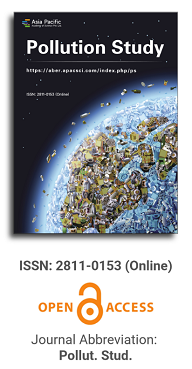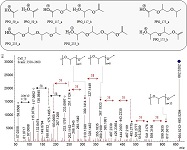
Asia Pacific Academy of Science Pte. Ltd. (APACSCI) specializes in international journal publishing. APACSCI adopts the open access publishing model and provides an important communication bridge for academic groups whose interest fields include engineering, technology, medicine, computer, mathematics, agriculture and forestry, and environment.

The (partial) replacement of synthetic polymers with bioplastics is due to increased production of conventional packaging plastics causing for severe environmental pollution with plastics waste. The bioplastics, however, represent complex mixtures of known and unknown (bio)polymers, fillers, plasticizers, stabilizers, flame retardant, pigments, antioxidants, hydrophobic polymers such as poly(lactic acid), polyethylene, polyesters, glycol, or poly(butylene succinate), and little is known of their chemical safety for both the environment and the human health. Polymerization reactions of bioplastics can produce no intentionally added chemicals to the bulk material, which could be toxic, as well. When polymers are used to food packing, then the latter chemicals could also migrate from the polymer to food. This fact compromises the safety for consumers, as well. The scarce data on chemical safety of bioplastics makes a gap in knowledge of their toxicity to humans and environment. Thus, development of exact analytical protocols for determining chemicals of bioplastics in environmental and food samples as well as packing polymers can only provide warrant for reliable conclusive evidence of their safety for both the human health and the environment. The task is compulsory according to legislation Directives valid to environmental protection, food control, and assessment of the risk to human health. The quantitative and structural determination of analytes is primary research task of analysis of polymers. The methods of mass spectrometry are fruitfully used for these purposes. Methodological development of exact analytical mass spectrometric tools for reliable structural analysis of bioplastics only guarantees their safety, efficacy, and quality to both humans and environment. This study, first, highlights innovative stochastic dynamics equations processing exactly mass spectrometric measurands and, thus, producing exact analyte quantification and 3D molecular and electronic structural analyses. There are determined synthetic polymers such as poly(ethylenglycol), poly(propylene glycol), and polyisoprene as well as biopolymers in bags for foodstuffs made from renewable cellulose and starch, and containing, in total within the 20,416–17,495 chemicals per sample of the composite biopolymers. Advantages of complementary employment in mass spectrometric methods and Fourier transform infrared spectroscopy is highlighted. The study utilizes ultra-high resolution electrospray ionization mass spectrometric and Fourier transform infrared spectroscopic data on biodegradable plastics bags for foodstuffs; high accuracy quantum chemical static methods, molecular dynamics; and chemometrics. There is achieved method performance |r| = 0.99981 determining poly(propylene glycol) in bag for foodstuff containing 20,416 species and using stochastic dynamics mass spectrometric formulas. The results highlight their great capability and applicability to the analytical science as well as relevance to both the fundamental research and to the industry.
Investigative analysis of the impact of low-level air pollution NO2 on mortality rates among residents due to cardiovascular and cerebrovascular diseases
Vol 3, Issue 1, 2022
Download PDF
Abstract
Keywords
References
- Xu R, Zhang H, Pan J, et al. Research Progress on the effects of short-term exposure to air pollutants on cardiac arrest events. Public health and preventive medicine. 2020; 31(3): 112-116.
- Eum KD, Kazemiparkouhi F, Wang B, et al. Long-term NO2 exposures and cause-specific mortality in American older adults. Environment International. 2019; 124: 10-15. doi: 10.1016/j.envint.2018.12.060
- Li Y, Xu R, Zhang H, et al. Effects of atmospheric fine particulate matter exposure on ischemic heart disease. Public health and preventive medicine. 2021; 32(4): 120-125.
- Huang L, Li J, Liu F, et al. Time series study on the impact of air pollutants on the death of permanent residents in Yancheng City. Public health and preventive medicine. 2021; 32(4): 18-22.
- Tan F, Wang W, Qi S, et al. Air pollutants and outpatient visits for cardiovascular disease in a severe haze-fog city: Shijiazhuang, China. BMC Public Health. 2019; 19(1). doi: 10.1186/s12889-019-7690-4
- Liu Y, Sun J, Gou Y, et al. Analysis of Short-Term Effects of Air Pollution on Cardiovascular Disease Using Bayesian Spatio-Temporal Models. International Journal of Environmental Research and Public Health. 2020; 17(3): 879. doi: 10.3390/ijerph17030879
- Taj T, Stroh E, Åström DO, et al. Short-Term Fluctuations in Air Pollution and Asthma in Scania, Sweden. Is the Association Modified by Long-Term Concentrations? Larcombe A, ed. PLOS ONE. 2016; 11(11): e0166614. doi: 10.1371/journal.pone.0166614
- Shan J, Li HY, Liu GF, et al. Effect of air pollution on health service demand of the elderly and middle-age patients with hypertension, cardiovascular and cerebrovascular diseases: based on analysis of data from CHARLS. Health sciences. 2016; 48(3): 460-464.
- Health statistics and information center of the Ministry of health Application instruction manual of international classification of diseases (ICD 10). Beijing: Peking Union Medical University Press; 2001.
- Cao X, Cui X, Wang B, et al. Cause of death monitoring and life loss analysis of permanent residents in Enshi City from 2013 to 2018. Public health and preventive medicine. 2021; 32(1): 27-31.
- Wang F, Liu H, Li H, et al. Ambient concentrations of particulate matter and hospitalization for depression in 26 Chinese cities: A case-crossover study. Environment International. 2018; 114: 115-122. doi: 10.1016/j.envint.2018.02.012
- Wang L, Liu C, Meng X, et al. Associations between short-term exposure to ambient sulfur dioxide and increased cause-specific mortality in 272 Chinese cities. Environment International. 2018; 117: 33-39. doi: 10.1016/j.envint.2018.04.019
- Yin P, Chen R, Wang L, et al. Ambient Ozone Pollution and Daily Mortality: A Nationwide Study in 272 Chinese Cities. Environmental Health Perspectives. 2017; 125(11). doi: 10.1289/ehp1849
- Song G, Zhu L, Gao A, et al. Blockwise AICc and its consistency properties in model selection. Communications in Statistics - Theory and Methods. 2019; 50(13): 3198-3213. doi: 10.1080/03610926.2019.1691734
- Liu C, Liu Y, Zhou Y, et al. Short-term effect of relatively low level air pollution on outpatient visit in Shennongjia, China. Environmental Pollution. 2019; 245: 419-426. doi: 10.1016/j.envpol.2018.10.120
- Qin M, Li J, Chen L, et al. Study on the impact of major air pollutants on the death of local residents from circulatory system diseases in Fengxian District. Journal of Southeast University (Medical Edition). 2014; 33(3): 304-310.
- Li W, Cao Y, Li R, et al. The spatial variation in the effects of air pollution on cardiovascular mortality in Beijing, China. Journal of Exposure Science & Environmental Epidemiology. 2018; 28(3): 297-304. doi: 10.1038/jes.2016.21
- Phung D, Hien TT, Linh HN, et al. Air pollution and risk of respiratory and cardiovascular hospitalizations in the most populous city in Vietnam. Science of The Total Environment. 2016; 322-330. doi: 10.1016/j.scitotenv.2016.03.070
- Zhong P, Huang S, Zhang X, et al. Individual-level modifiers of the acute effects of air pollution on mortality in Wuhan, China. Global Health Research and Policy. 2018; 3(1). doi: 10.1186/s41256-018-0080-0
- Stieb DM, Berjawi R, Emode M, et al. Systematic review and meta-analysis of cohort studies of long term outdoor nitrogen dioxide exposure and mortality. Forloni G, ed. PLOS ONE. 2021; 16(2): e0246451. doi: 10.1371/journal.pone.0246451
- Guo H, Huang K, Zhang X, et al. Women are more susceptible than men to oxidative stress and chromosome damage caused by polycyclic aromatic hydrocarbons exposure. Environmental and Molecular Mutagenesis. 2014; 55(6): 472-481. doi: 10.1002/em.21866
- Amsalu E, Wang T, Li H, et al. Acute effects of fine particulate matter (PM2.5) on hospital admissions for cardiovascular disease in Beijing, China: a time-series study. Environmental Health. 2019; 18(1). doi: 10.1186/s12940-019-0506-2
- Pan Y, Thapa D, Baldissera L, et al. Relevance of TRPA1 and TRPM8 channels as vascular sensors of cold in the cutaneous microvasculature. Pflügers Archiv - European Journal of Physiology. 2017; 470(5): 779-786. doi: 10.1007/s00424-017-2085-9
Supporting Agencies
Copyright (c) 2022 Zesheng Che, Xiuqing Cui, Bin Wang, Yanlin Hui, Lan Dai, Xueqin Cao, Chunhong Wang, Tingming Shi

This work is licensed under a Creative Commons Attribution 4.0 International License.

This site is licensed under a Creative Commons Attribution 4.0 International License (CC BY 4.0).
.jpg)
Beijing University of Technology, China



